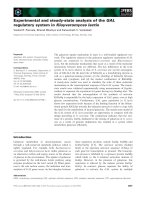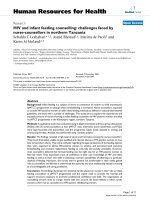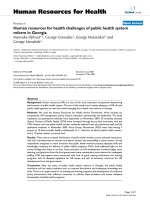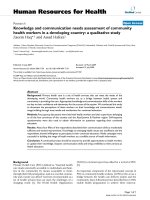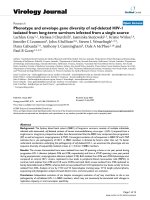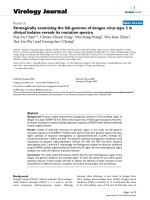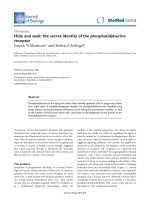Báo cáo sinh học: "Etiology and antibiotic resistance patterns of community-acquired urinary tract infections in J N M C Hospital Aligarh, India" potx
Bạn đang xem bản rút gọn của tài liệu. Xem và tải ngay bản đầy đủ của tài liệu tại đây (262.82 KB, 7 trang )
BioMed Central
Page 1 of 7
(page number not for citation purposes)
Annals of Clinical Microbiology and
Antimicrobials
Open Access
Research
Etiology and antibiotic resistance patterns of community-acquired
urinary tract infections in J N M C Hospital Aligarh, India
Mohammed Akram
1
, Mohammed Shahid
2
and Asad U Khan*
1
Address:
1
Interdisciplinary Biotechnology Unit, Aligarh Muslim University Aligarh 202002 India and
2
Microbiology Department, JN Medical
College and Hospital, AMU, Aligarh India
Email: Mohammed Akram - ; Mohammed Shahid - ; Asad U Khan* -
* Corresponding author
Abstract
Background: Urinary tract infections (UTIs) remain the common infections diagnosed in
outpatients as well as hospitalized patients. Current knowledge on antimicrobial susceptibility
pattern is essential for appropriate therapy. Extended-Spectrum beta-Lactamase (ESBL) producing
bacteria may not be detected by routine disk diffusion susceptibility test, leading to inappropriate
use of antibiotics and treatment failure. The aim of this study was to determine the distribution and
antibiotic susceptibility patterns of bacterial strains isolated from patients with community acquired
urinary tract infections (UTIs) at Aligarh hospital in India as well as identification of ESBL producers
in the population of different uropathogens.
Methods: Urinary isolates from symptomatic UTI cases attending to the JN Medical College and
hospital at Aligarh were identified by conventional methods. Antimicrobial susceptibility testing was
performed by Kirby Bauer's disc diffusion method. Isolates resistant to third generation
cephalosporin were tested for ESBL production by double disk synergy test method.
Results: Of the 920 tested sample 100 samples showed growth of pathogens among which the
most prevalent were E. coli (61%) followed by Klebsiella spp (22%). The majority (66.66%) of the
isolates were from female while the remaining were from male. Among the gram-negative enteric
bacilli high prevalence of resistance was observed against ampicillin and co-trimoxazole. Most of
the isolates were resistant to 4 or more number of antibiotics. Forty two percent of isolates were
detected to produce ESBL among which 34.42 % were E. coli isolates.
Conclusion: This study revealed that E. coli was the predominant bacterial pathogen of community
acquired UTIs in Aligarh, India. It also demonstrated an increasing resistance to Co-trimoxazole
and production of extended spectrum β-lactamase among UTI pathogens in the community. This
study is useful for clinician in order to improve the empiric treatment.
Background
Urinary tract infection (UTI) is the second most common
infectious presentation in community practice. World-
wide, about 150 million people are diagnosed with UTI
each year, costing the global economy in excess of 6 bil-
lion US dollars [1]. UTI may involve only the lower uri-
nary tract or may involve both the upper and lower tract.
The term cystitis has been used to describe lower UTI,
Published: 23 March 2007
Annals of Clinical Microbiology and Antimicrobials 2007, 6:4 doi:10.1186/1476-0711-6-4
Received: 14 November 2006
Accepted: 23 March 2007
This article is available from: />© 2007 Akram et al; licensee BioMed Central Ltd.
This is an Open Access article distributed under the terms of the Creative Commons Attribution License ( />),
which permits unrestricted use, distribution, and reproduction in any medium, provided the original work is properly cited.
Annals of Clinical Microbiology and Antimicrobials 2007, 6:4 />Page 2 of 7
(page number not for citation purposes)
which is characterized by a syndrome involving dysuria,
frequency, urgency and occasionally suprapubic tender-
ness. However, the presence of symptoms of lower tract
without upper tract symptoms does not exclude upper
tract infection, which is also often present [2].
UTIs are often treated with different broad-spectrum anti-
biotics when one with a narrow spectrum of activity may
be appropriate because of concerns about infection with
resistant organisms. Fluoroquinolone are preferred as ini-
tial agents for empiric therapy of UTI in area where resist-
ance is likely to be of concern [3,4]. This is because they
have high bacteriological and clinical cure rates, as well as
low rates of resistance, among most common uropatho-
gens [5-7]. The extensive uses of antimicrobial agents have
invariably resulted in the development of antibiotic resist-
ance, which, in recent years, has become a major problem
worldwide [8].
The resistance pattern of community acquired UTI patho-
gens has not been studied extensively [5]. The etiology of
UTI and the antibiotic resistance of uropathogenes have
been changing over the past years, both in community
and nosocomial infection [9,10]. However, there are not
much information on etiology and resistance pattern of
community acquired UTIs in India is available. This retro-
spective study was conducted to compare the frequency
and drug resistance pattern in uropathogenes isolated
from patients with community acquired UTIs in Aligarh,
India as well as identification of ESBL producer strains
among the uropathogens. This study is important for cli-
nician in order to facilitate the empiric treatment of
patients and management of patients with symptoms of
UTIs. Moreover, the data would also help authorities to
formulate antibiotic prescription policies.
Materials and methods
Sample collection and analysis
The study was conducted on patients attending outpatient
clinics at the J.N.M.C.H, A.M.U., Aligarh between August
2004 and July 2005. Freshly voided midstream specimens
of urine (n = 920) were submitted to the clinical microbi-
ology laboratory of J.N.M.C.H, Aligarh for processing.
Semi quantitative urine culture using a calibrated loop
was used to inoculate blood agar and MacConkey plates
[11]. Following the recommendations of Kass [12] in dis-
tinguishing genuine infection from contamination, signif-
icant monomicrobic bacteriuria was defined as culture of
a single bacterial species from the urine sample at a con-
centration of >10
5
cfu/ml. Only a single positive culture
per patient was included in the analysis. The significant
pathogens were identified by standard biochemical proce-
dures [13]. Hi-Media kits' manufacturer instructions were
followed to identify species of these genera. Hi25™
Enterobacteriaceae identification kit and Hi E. coli™ Iden-
tification Kit were used. In addition Himedia Vogel-John-
son Agar was used for S. aureus, Hi media HiChrome ECC
Agar was used for E. coli (Blue colony), K. pneumoniae
(Rose pink colony) and P. aeruginosa (Star color colony).
UTI patients included in this study were classified as
young and middle aged (20–49 years), pediatrics (New
born to 19 years) and elderly patients (50–80 years).
Antibiotic susceptibility testing
Antimicrobial susceptibility testing was performed using
the disk diffusion method as described by the National
Committee for Clinical Laboratory Standards (presently
called as Clinical Laboratory Standard Institute) [14].
Antimicrobial agents (disks) tested and reported were
obtained from Hi-Media labs, Mumbai, India.
E. coli ATCC 25922, S. aureus ATCC 29213, P. aeruginosa
ATCC 27853, E. faecalis ATCC 29212, E. coli BCC 2132
(ESBL producer), and E. coli ATCC 35218 (non-ESBL pro-
ducer) were used as quality control strains. Interpretative
criteria for each antimicrobial tested were those recom-
mended by the NCCLS-2000 [14]
ESBL Detection by NCCLS phenotypic method
The NCCLS-ESBL phenotypic confirmatory test with
ceftazidime, cephotaxime, ceftriaxone and cefixime were
performed for all the isolates by disk diffusion method on
Mueller-Hinton agar plates with and without 10 μg of
amoxyclav. Susceptibility test results were interpreted
according to the criteria established by the NCCLS [15]. A
≥ 5-mm increase in the zone of diameter of third genera-
tion cephalosporins, tested in combination with amoxy-
clav versus its zone when tested alone was considered
indicative of ESBL production. E. coli ATCC 25922 was
used as ESBL negative and K. pneumoniae 700603 was used
are ESBL positive reference strain.
Statistical analysis
To analyze the data it was reported in the form of diameter
of inhibition zone during susceptibility testing of all bac-
terial isolates by disc diffusion test against different classes
of antimicrobial agents. One-way ANOVA was performed
to check the significant difference among the different
groups. A difference was considered significant if the
probability that chance would explain the results was
reduced to less than 5% (p ≤ 0.05). The normality and
homogeneity was also checked.
Results
Of the 920 urine samples processed 100 (10.86%) gave
significant growth of pathogens. The patients were
between new born and 80 years of age. More cases of UTIs
were recorded among young and middle age patients (20–
49 years, 51.04%). Pediatric patients (new born to 19
years) comprised 36.45% and elderly (50–80 years) con-
Annals of Clinical Microbiology and Antimicrobials 2007, 6:4 />Page 3 of 7
(page number not for citation purposes)
stituted 16.66 % of the total number. More organisms
were isolated from women (66.66 %) than from men
(33.34 %).
Age and gender wise data of prevalence of uropathogenes
revealed that E. coli (87%) Klebsiella pneumoniae (89%)
Psueodomonas aeruginosa (100%) and Acinetobacter bau-
mannii (67%) infection was found to be more prevalent
among middle aged female candidates as shown in table
1. Moreover, none of the P. aeruginosa and A. baumannii
were found in pediatric patients (NB to 19 years) whereas
Acinetobacter spps. were not observed among elderly
patients (50–80 years) in our study (table 1).
Of the 100 significant isolates, gram-negative aerobic rods
accounted for 92 % while gram-positive cocci accounted
for the remaining 8 % of the total pathogens. The fre-
quency and distribution of the different microorganisms
is summarized in Table 2. E. coli (61%), K. pneumoniae.
(22%), P. aeruginosa (4.0%), S. aureus (7.0%), A. bauman-
nii. (3.0%), Citrobacter spp. (2.0%) and E. faecalis (1.0%)
were the most prevalent microorganisms in UTI patients.
Frequency of UTIs was found more in elderly patients
(51.04 %), principally women (66.66 %) than in pediat-
ric patients.
The antimicrobial potency and spectrum for 17 selected
antimicrobial agents of different classes against the five
most frequent UTI pathogens are summarized in table 2.
Among the β-lactum antibiotics, imipenem had the wid-
est coverage against E. coli isolates (100%), followed by
amikacin (49%), and extended spectrum cephalosporins
(15–45%). Moreover, a high potency of the fluoroqui-
nolones against E. coli was observed.
Our Klebsiella isolates showed high percent susceptibility
against imipenem (88%) followed by amikacin and
cephotaxime (59%) and ceftriaxone (53%). Nitrofuran-
toin, tetracycline, co-trimoxazole, and cefpodoxime were
found to be highly resistant (100%) against Pseudomonas
isolates. Among the beta lactam antibiotics, imipenem
had the widest coverage against gram-negative isolates
(100%). This was followed by the amikacin, ciprofloxacin
and norfloxacin (67%).
Imipenem, amikacin, ciprofloxacin and norfloxacin
showed highest percent susceptibility (100%) against A.
baumannii in this study. Third and fourth generation
cephalosporins were found to be more effective with sig-
nificant percent susceptibility (67%) against Acinetobacter
isolates. Aminoglycosides and macrolides also had the
same percent susceptibility (67%). Whereas, all Staphylo-
coccus aureus isolates were found to be susceptible against
imipenem, ceftriaxone and cephotaxime. The high resist-
ance rate (60%) against cefpodoxime, nalidixic acid and
aztreonem was also observed among these isolates.
Age wise distribution of antibiotic resistance pattern
revealed that uropathogens isolated from the patients of
different age groups showed slight variation in percent
resistance against different antibiotics. It was found that
percent resistance against different generation of cepha-
losporin was found to be 60–80 % in pediatrics patients
whereas 40–70% was observed among elderly and middle
aged patients. Moreover, 2–3% isolates among middle
aged and pediatric patients were resistant against imi-
penim while no resistance against imipenim was seen
against elderly patients. Percent resistance against nor-
floxacin was quite high (74%) among pediatric patients
compare to middle aged and elderly patients (55%). Rate
of resistance against gentamycin was higher (75%) among
pediatric patients than elderly and middle aged patients
(50 %). Moreover, almost all of the isolates included in
this study were found resistant to four or more antibiotics
as shown in table 3. Twenty two different resistant pat-
terns were observed among 61 E. coli strains. Each of these
patterns was common in 1 or up to 3 strains. Moreover, an
interesting finding was that pattern 2 was repeated in 26
E. coli strains as shown in table 3. Resistance patterns
among Klebsiella pneumoniae was also varied, fourteen dif-
ferent patterns were observed among twenty two strains
(Table 3).
Table 1: Age and gender wise distribution and frequency of uropathogenes isolated from community acquired infection
Age groups Uropathogenes
E. coli K. pneu S. aureus P. aerog A. baum
M(%) F(%) M(%) F(%) M(%) F(%) M(%) F(%) M(%) F(%)
NB-19 years 32 68 40 60 0 100
20–49 years 13 87 11 89 40 60 0 100 33 67
50–80 years 44 56 17 83 0 100 100 0
NB = New born, K. pneu = Klebsiella pneumoniae, S. aureus = Staphylococcous aureus, P. aerog = Psueodomonas aeruginosa, A. baum = Acinetobacter
baumannii.
Annals of Clinical Microbiology and Antimicrobials 2007, 6:4 />Page 4 of 7
(page number not for citation purposes)
A total of 42% isolates were found to produce ESBL
detected by the double disc diffusion test. Table 3 shows
the frequency of ESBL producers for different UTI patho-
gens. Among the five most frequent UTI pathogens, E. coli
(34.42 %) and Klebsiella pneumoniae. (27.3 %) were most
prevalent ESBL producers. Other isolates were also ESBL
producers but their numbers were insignificant as shown
in table 2.
Statistical analysis revealed that the data obtained was
obeying the normality as well as principle of homogeneity
throughout, p-values were also calculated as indicated in
Table 2.
Discussion
This study shows the distribution and antibiotic suscepti-
bility pattern of microbial species isolated from patients
with community acquired UTIs in J.N.M.C.H, Aligarh.
These organisms cause a variety of infections including
UTIs [16]. In this study urinary samples of children were
also included. A majority of pathogens were isolated from
adult patients (51.04 %), principally women (66.66 %). It
has been extensively reported that adult women have a
higher prevalence of UTI than men, principally owing to
anatomic and physical factors [8,17].
Antibiotic resistance is a major clinical problem in treat-
ing infections caused by these microorganisms. The resist-
ance to the antimicrobials has increased over the years.
Resistance rates vary from country to country [18]. Over-
all, isolates from Latin American countries show the low-
est susceptibility rates to all antimicrobial agents followed
by Asian-Pacific isolates and European strains. Strains
from Canada exhibit the best global susceptibility testing
results. (SENTRY Antimicrobial Surveillance Program,
SASP) [18]. In our study, it accounted for approximately
61% of all clinically significant urinary isolates and 63%
of all Enterobacteriaceae. This is consistent with the find-
ings of previous studies in which E. coli was the predomi-
nant pathogen isolated from patients with community
acquired UTIs [9,19]. However, Klebsiella pneumoniae are
rarely encountered in cases of community-acquired UTI
[8,9,20]. In the present study 22% of Klebsiella isolates
were found to be present among all uropathogens stud-
ied. These isolates shows resistance against first genera-
tion cephalosporin, cephalothin, aminoglycosides,
macrolides and lincosamides which is consistent with the
previous data of other community- based studies [21].
Our E. coli and Klebsiella isolates are equally resistant to
ampicillin (76% and 75% respectively) while for Co-tri-
moxazole, E. coli is more resistant (75%) than Klebsiella
(53%) in this region. Indian isolates showed higher resist-
ance against ampicillin and co-trimoxazole than the iso-
lates from USA (39.1% and 18.6 % respectively) [22] and
Europe (29.8% and 14.1% respectively) [23]. On the
other hand, rate of resistance against these antibiotics in
countries like Senegal (77% and 55%), Spain, (65% and
33%), Taiwan (80% and 56%), and Israel (66% and 26%)
is comparable with Indian isolates [24-27].
In this study E. coli and Klebsiella isolatesare highly resist-
ant against nitrofurantoin (80% and 76% resistant respec-
tively). Whereas, this drug exhibited low resistance rate in
the major part of the world (0–5.4%), despite of it's being
used for many years [28]. This is probably due to the fact
Table 2: Frequency and resistance pattern of most frequently occurring UTI pathogens against 17 selected antimicrobial agents tested
and % ESBL production.
Frequency and Distribution of
Uropathogens
Percentage (%) of resistance to antimicrobial agent
Microorganis
ms identified
No. of isolates
& percent (%)
occurence
Cn Ca Ce Ci Cep Cpm G Tb Ak Pc I Ao Cf Nx* T Co Nf ESBL
producers (%)
Cep
2
Cep
3
Cep
4
Amn P C M Q F Others
E. coli 61 69 65 56 55 85 67 64 73 51 84 0 75 69 69 76 76 80 34.42
K. pneumoniae 22 53 53 41 47 65 53 53 53 35 82 12 59 47 47 53 53 76 27.3
S. aureus 07 40 40 0 0 60 20 20 20 20 40 0 60 40 40 40 40 20 -
P. aeruginosa 04 67 67 67 67 100 67 67 67 33 67 0 67 33 33 100 100 100 -
A. baumannii03 67673333673333330670670 0 3333 33-
p-values 0.551 0.054 0.021 0.0002 0.017 0.319 0.212 0.318 0.076 0.047
Significant at p-value of < 0.05
* p value = 0.000
Ak = amikacin; Ao = aztreonem; C = chloramphenicol; Co = cotrimoxazole; Cpm = cefepime; Cep = cefpodoxime; Ca = ceftazidime; Ce =
cephotaxime; Ci = ceftriaxone; Cn = cephoxitin; Cf = ciprofloxacin; G = gentamicin; Tb = tobramycin; I = imipenem; Pc = piperacillinl; T =
tetracycline; Nf = nitrofurantoin; Nx = norfloxacin. Cep
2
= Second generation cephalosporins, Cep
3
= Third generation,Cep
4
= Fourth generation
cephalosporins, Amn = Aminoglycosides, Mon = Monobactam, P = piperacillin, Q = Quinolones, F = Fluoroquinolones, C = Carbapenems, Others
= T, Co and Nf.
Annals of Clinical Microbiology and Antimicrobials 2007, 6:4 />Page 5 of 7
(page number not for citation purposes)
that this antibiotic has been widely used in treating com-
munity-acquired UTIs over the past decade in this region
[29-31]. The resistance rate of E. coli to extended spectrum
cephalosporins ranges from 55% to 85%, which is con-
Table 3: Resistance patterns of uropathogens isolated in this study
Uropathogens Resistance Patterns No. of isolates
E. coli :
1. Cep
2
, Cep
3
, Cep
4
, Amn, Mon, Pen, Qun, Fqn, T, Nf. 01
2. Cep
2
, Cep
3
, Cep
4
, Amn, Mon, Pen, Qun, Fqn, T, Nf, Co. 26
3. Cep
2
, Cep
3
, Cep
4
, Mon, Qun. 02
4. Cep
4
, Mon, Pen, Qun. 01
5. Pen, Amn. 02
6. Cep
3
, Amn, Pen, Qun, Fqn, T, Nf, Co. 02
7. Cep
3
, Amn, Pen, Qun, Fqn, Mon, Co. 02
8. Cep
2
, Cep
3
, Cep
4
, Mon, Pen, T, Nf. 02
9. Cep
3
, T, Nf, Co, Amn, Pen, Mon, Qun. 02
10. Nf, Co, Amn, Mon, Pen, Qun, Fqn. 01
11. T, Nf, Co, Amn, Pen. 02
12. Cep
2
, Cep
3
, Cep
4
, Amn, Mon, Pen, Qun, Fqn, Nf. 02
13. Cep
2
, Cep
4
, Qun, Nf. 01
14. Cep
2
, Cep
3
, Cep
4
, Amn, Mon, Pen, Qun, T, Co. 03
15. Pen, T, Nf, Co. 01
16. Nf. 01
17. Cep
3
, Cep
4
, Amn, Mon, Pen, Qun, Fqn, T, Nf, Co. 02
18. Cep
2
, Cep
4
, Qun, Nf, T, Co. 01
19. Cep
2,
Amn, Pen, Qun, Fqn, T. 02
20. Cep
3,
Pen, Qun, Fqn, T, Co. 02
21. Cep
2
, Cep
3
, Amn, Mon, Pen, Qun, Fqn, T, Co. 02
22. Cep
4
, Mon, Qun, Nf. 01
K. pneumoniae :
1. Cep
2
, Cep
3
, Cep
4
, Amn, Mon, Pen, Qun, Fqn, T, Nf. 04
2. Cep
3
, Cep
4
, Mon, Pen, Qun. 02
3. Cep
2
, Amn, Mon, Pen, Qun, T, Nf. 02
4. Pen, Fqn, T, Co. 01
5. Pen, Nf. 01
6. Cep
3
, Cep
4
, Amn, Mon, Pen, Qun, Fqn, T, Nf, Co. 02
7. Cep
3
, Pen, T. 01
8. Resistant to all the groups. 01
9. Pens, Nf. 01
10. Resistant to all except Car and T. 01
11. Cep
2
, Cep
3
, Cep
4
, Car, Pen, T, Nf. 02
12. Cep
2
, Cep
3
, Cep
4
, Mon, Pen, Nf. 02
13. Resistant to all except Car. 01
14. Cep
2
, Cep
3
, Cep
4
, Mon, Pen, Qun, Fqn, Nf, Co. 01
P. aeruginosa
1. Cep
2
, Cep
3
,Cep
4
, Amn, Mon, Pen, Qun, Fqn, T, Co, Nf. 01
2. Cep
2
, Cep
3
, Cep
4
, Amn, Mon, Pen,Qun, T, Nf, Co. 02
3. Cep
2
, Pen, Qun, T, Nf, Co. 01
A. baumannii
1. Cep
2
, Pen, T. 01
2. Cep
2
, Cep
3
,Cep
4
, Mon, Amn, Pen, Qun, Co, Nf. 01
3. Cep
3
, Qun, Mon. 01
S. aureus
1. Mon, Cep
3
, Amp, Qun, fqn,, Co. 02
2. Cep
2
, Cep
3
, Pen, Qun, Fqn, T, Mon. 02
3. Cep
3
, Mon, Qun. 01
4. Cep
2
, Cep
4
,Pen, Fqn, Amn, T, Nf, Co. 02
Abbreviations:
Cep
2
= Second generation cephalosporins, Cep
3
= Third generation,Cep
4
= Fourth generation cephalosporins, Amn = Aminoglycosides, Mon =
Monobactam, Pen = Penicillins, Qun = Quinolones,Fqn = Fluoroquinolones, Co = Cotrimoxazole, T = Tetracycline,Nf = Nitrofurantoin, Car =
Carbapenems.
Annals of Clinical Microbiology and Antimicrobials 2007, 6:4 />Page 6 of 7
(page number not for citation purposes)
trary to other community-acquired UTI studies in Europe,
Israel and the US [27,29-32]. Higher resistance rate to all
antibiotics used in this study with the exception of imi-
penem and amikacin may be explained as uncontrolled
consumption of these antibiotics during the past decade
in our region [29-31].
In the present study overall imipenem resistance was 12 %
for Klebsiella pneumoniae, whereas, other isolates of
uropathogens were found to be sensitive to imipenem. It
is highly stable against β-lactamase and has an unusual
property of causing a post antibiotic effect on gram-nega-
tive bacteria [33]. Due to its small molecular size it can
over come the poor permeability of β-lactams for Pseu-
domonas by efficient penetration through the porin, OMP
D [34]. Extended spectrum cephalosporins showed
remarkable rates of resistance against E. coli, K. pneumo-
niae, S. aureus, A. baumannii, and P. aeruginosa. All S.
aureus isolates were susceptible to third generation cepha-
losporins i.e. cephotaxime and ceftriaxone. Whereas,
among P. aerugonisa all isolates showed resistance to cef-
podoxime and cefuroxime. All Acinetobacter isolates were
susceptible to amikacin and fluoroquinolones. The
reported resistance varies from 10 to 30% in P. aeruginosa.
and 3 to 10.3% in A. baumannii
In this study, 42 out of 100 isolates of UTI pathogens
(42%) were found to produce ESBL. High prevalence rate
of ESBL producing strains have also been reported earlier
in K. pneumoniae. [35,6]. This is consistent with other drug
resistance groups in India (48.3%) [7]. A 34.42 % of our
E. coli isolates were ESBL producers, followed by 27.3% of
K. pneumoniae. It might be possible that the high level of
multi-drug resistance was most probably due to produc-
tion of extended spectrum beta lactamases in these iso-
lates [36-38]. More studies are required to know the exact
magnitude of the problem in India.
Conclusion
It is quite alarming to note that almost all of the isolates
included in this study were found resistant to four or more
antibiotics. Antibiotic resistance is becoming a big prob-
lem for the public health which threaten the lives of hos-
pitalized individual as well as those with chronic
conditions and add considerably to health care cost.
Therefore, it is an important issue to be addressed by the
policy makers to formulate a strict antibiotics prescription
policy in our country. Moreover, this study concludes that
E. coli and other isolates were more sensitive to imipenem
and amikacin compared to the other antibiotics tested
and therefore these may be the drugs of choice for the
treatment of community-acquired UTIs in our region.
Competing interests
The author(s) declare that they have no competing inter-
ests.
Authors' contributions
MA has collected the sample and characterized bacterial
isolates from UTI with the collaboration of MS. MA has
performed all the experiments incorporated in this manu-
script. AUK has designed the problem and guide through-
out this study as well as helped in writing this manuscript.
MA has written first draft of manuscript.
Acknowledgements
This work was supported by Internal funds of Biotechnology Unit, AMU
and CSIR grant no. 37(1209)/04/EMR-II. MA acknowledges CSIR for the
financial support. DBT, Government of India is also acknowledged for the
financial support. I thanks to the staff of Microbiology department JNMCH,
AMU Aligarh for providing patients isolates especially, Prof. Mithlesh
Agrawal. The experiments comply with the current laws of the country in
which they were performed.
References
1. Gonzalez CM, Schaeffer AJ: Treatment of urinary tract infec-
tion: what's old, what's new, and what works. World J Urol
1999, 6:372-382.
2. Sobel JD, Kaye D: Urinary tract infections. In Mandell, Douglas and
Bennett's. Principals and practice of infectious diseases 5th edition. Edited
by: Mandell GL, Bennett JE, Dolin R. Philadelphia: Churchill Living-
stone; 2000.
3. Schaeffer AJ: The expanding role of fluoroquinolones. Am J Med
2002, 113(Suppl 1A):45S-54S.
4. Biswas D, Gupta P, Prasad R, Singh V, Arya M, Kumar A: Choice of
antibiotic for empirical therapy of acute cystitis in a setting
of high antimicrobial resistance. Indian J Med Sci 2006,
60(2):53-8.
5. Goldstein FW: Antibiotic susceptibility of bacterial strains iso-
lated from patients with community-acquired urinary tract
infections in France. Multicentre Study Group. Eur J Clin Micro-
biol Infect Dis 2000, 19:112-117.
6. Gupta V, Yadav A, Joshi RM: Antibiotic resistance pattern in
uropathogen. Indian J Med Microbiol 2002, 20:96-98.
7. Tankhiwale SS, Jalgaonkar SV, Ahamad S, Hassani U: Evaluation of
extended spectrum beta lactamase in urinary isolates. Indian
J Med Res 2004, 120:553-556.
8. Kumar MS, Lakshmi V, Rajagopalan R: Related Articles, Occur-
rence of extended spectrum beta-lactamases among
Enterobacteriaceae spp. isolated at a tertiary care institute.
Indian J Med Microbiol 2006, 24(3):208-11.
9. Manges AR, Natarajan P, Solberg OD, Dietrich PS, Riley LW: The
changing prevalence of drug-resistant Escherichia coli clonal
groups in a community: evidence for community outbreaks
of urinary tract infections. Epidemiol Infect 2006, 134(2):425-31.
10. Kahan NR, Chinitz DP, Waitman DA, Dushnitzky D, Kahan E, Shapiro
M: Empiric treatment of uncomplicated urinary tract infec-
tion with fluoroquinolones in older women in Israel: another
lost treatment option? Ann Pharmacother 2006, 40(12):2223-7.
11. Beckford-Ball J: Related Articles, Management of suspected
bacterial urinary tract infection. Nurs Times 2006, 102(36):25-6.
12. Girou E, Rioux C, Brun-Buisson C, Lobel B: Infection Committee
of the French Association of Urology. The postoperative
bacteriuria score: a new way to predict nosocomial infection
after prostate surgery. Infect Control Hosp Epidemiol 2006,
27(8):847-54.
13. McNulty CA, Bowen J, Clark G, Charlett A, Cartwright K, South
West G, Microbiology Laboratory Use Group: How should general
practitioners investigate suspected urinary tract infection?
Variations in laboratory-confirmed bacteriuria in South
West England. Commun Dis Public Health 2004, 7(3):220-6.
Publish with BioMed Central and every
scientist can read your work free of charge
"BioMed Central will be the most significant development for
disseminating the results of biomedical research in our lifetime."
Sir Paul Nurse, Cancer Research UK
Your research papers will be:
available free of charge to the entire biomedical community
peer reviewed and published immediately upon acceptance
cited in PubMed and archived on PubMed Central
yours — you keep the copyright
Submit your manuscript here:
/>BioMedcentral
Annals of Clinical Microbiology and Antimicrobials 2007, 6:4 />Page 7 of 7
(page number not for citation purposes)
14. National Committee for Clinical Laboratory Standards: Methods for
Disk Susceptibility Tests for Bacteria That Grow Aerobi-
cally. NCCLS Documant M2-A7. Wayne, National Committee for Clinical
Laboratory Standards 7th edition. 2000.
15. National Committee for Clinical Laboratory Standards: Perform-
ance standards for antimicrobial susceptibility testing. Inter-
national Supplement. NCCLS Committee for Clinical Laboratory Standards.
Wayne, Pa 11th edition. 2001.
16. Meharwal SK, Taneja N, Sharma SK, Sharma M: Complicated noso-
comial UTI caused by nonfermenters. Indian J Urol 2002,
18:123-128.
17. Khan AU, Musharraf A: Plasmid mediated multiple antibiotic
resistance in P. mirabilis isolated from the UTI patients. Med-
ical Sci Mon 2004, 10:598-602.
18. Gales AC, Jones RN, Turnidge J, Rennie T, Ramphal R: Characteri-
zation of Pseudomonas aeruginosa isolates: occurrence rates,
antimicrobial susceptibility patterns and molecular typing in
the global SENTRY antimicrobial surveillance program
1997–1999. Clin Infect Dis 2001, 32(S1):46-55.
19. Philippon A, Arlet G, Lagrange PH: Escherichia coli: Frequency de
resistance et evolution a divers antibiotiques urinaries dont
la fosfomycine en milieu hospitalier. Med Mal Infect 1996,
26:539-541.
20. Kunin CM: Urinary tract infections in females. Clin Infect Dis
1994, 18:1-12.
21. Dimitrov TS, Udo EE, Emara M, Awini F, Passadilla R: Etiology and
antibiotic susceptibility patterns of community-acquired uri-
nary tract infections in Kuwait hospital. Med Princ Pract 2003,
13:334-339.
22. Vromen M, van der Van AJ, Knols AM, Stobberingh EE: Antimicro-
bial resistance patterns in urinary tract isolates from nursing
homes residents. Fifteen years of data reviewed. J Antimicrob
Chemother 1999, 44:113-116.
23. Kahlmeter G: Prevalence and antimicrobial susceptibility of
pathogens in uncomplicated cystitis Europe. The ECO.
SENS study. Int J Antimicrob Agents 2003, 22:49-52.
24. Dromigny JA, Nabeth P, Perrier Gros Claude JD: Distrinution and
susceptibility of bacterial urinary tract infections in Dakar,
Senegal. Int J Antimicrob Agents 2002, 20:339-347.
25. Daza R, Gutierrez J, Piedrola G: Antibiotic susceptibility of bac-
terial strains isolated from patients with community-
acquired urinary tract infections. Int J Antimicrob Agents 2001,
18:211-215.
26. Lau SM, Peng MY, Chang FY: Resistance rates to commonly used
antimicrobilas among pathogens of both bacteremic and
non-bacteremic community-acquired urinary tract infec-
tion. J Microbial Immunol Infect 2004, 37:185-191.
27. Colodner R, Keness Y, Chazan B, Raz R: Antimicrobial suscepti-
bility of community-acquired uropathogens in northern
Israel. Int J Antimicrob Agents 2001, 18:189-192.
28. Honderlick P, Cahen P, Gravisse J, Vignon D: Uncomplicated uri-
nary tract infections, what about fosfomycin and nitrofuran-
toin in 2006? Pathol Biol 2006, 54:462-6.
29. Mudur G: Drug resistant cholera in India attributed to antibi-
otic misuse. BMJ 2000, 321:1368-9.
30. Svetlansky I, Liskova A, Foltan V, Langsadl L, Krcmery V: In creased
consumption of fluoroquinolones is not associated with
resistance in Escherichia coli and Staphylococcus aureous in
the community. J Antimicrob Chemother 2001, 48:457-458.
31. Hillier SL, Magee JT, Howard AJ, Palmer SR: How strong is the evi-
dence that antibiotic use is risk factor for antibiotic-resist-
ant, community -acquired urinary tract infection. J Antimicrob
Chemother 2002, 50:241-247.
32. Farrel DJ, Morrisey I, De Rubeis D, Robbins M, Felmingham D: A UK
multi-center study of the antimicrobial susceptibility of bac-
terial pathogens causing urinary tract infection. J Infect 2003,
46:94-100.
33. Neu HC: Resistance of Pseudomonas aeruginosa to imipenem.
Infect Control Hosp Epidemiol 1992,
13:7-9.
34. El Amin N, Giske CG, Jalal S, Keijser B, Kronvall G, Wretlind B: Car-
bapenem resistance mechanisms in Pseudomonas aerugi-
nosa: alterations of porin OprD and efflux proteins do not
fully explain resistance patterns observed in clinical isolates.
APMIS 2005, 113(3):187-96.
35. Akata F, Tatman-Otcum M, Ozkan E, Tansel O, Otkum M, Tugrul M:
Prevalence of extended spectrum beta lactamases produced
by nosocomial isolates of enterobacteriacae in Trakata Uni-
versity Hospital, Turkey. New Microbial 2003, 26:257-262.
36. Grover SS, Sharma M, Chattopadhya D, Kapoor H, Pasha ST, Singh G:
Phenotypic and genotypic detection of ESBL mediated
cephalosporin resistance in Klebsiella pneumoniae: emer-
gence of high resistance against cefepime, the fourth gener-
ation cephalosporin. J Infect 2006, 53(4):279-88.
37. Mathai D, Rhomberg PR, Biedenbach DJ, Jones RN, India Antimicro-
bial Resistance Study Group: Evaluation of the in vitro activity of
six broad-spectrum beta-lactam antimicrobial agents tested
against recent clinical isolates from India: a survey of ten
medical center laboratories. Diagn Microbiol Infect Dis 2002,
44(4):367-77.
38. Mohanty S, Singhal R, Sood S, Dhawan B, Das BK, Kapil A: Compar-
ative in vitro activity of beta-lactam/beta-lactamase inhibi-
tor combinations against gram negative bacteria. Indian J Med
Res 2005, 122(5):425-8.


